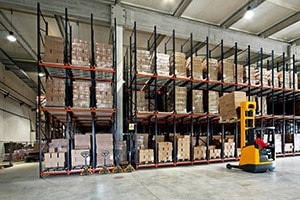What is a channel storage system?
Advantages of the special shelving explained simply
When it comes to efficient warehouse management, classic pallet racking is still the standard today. It can be flexibly adapted to requirements, expanded in many ways and integrated into the processes on site. However, standard designs are not always suitable for every application scenario. In this context, a channel storage system is a special rack, a variation on the classic high-bay pallet rack, so to speak.
proLogistik explains the structure of a channel storage system, highlights the advantages and disadvantages and provides application examples for a better understanding.
Basically: How is the channel storage system structured?
If a company keeps a manageable number of items in stock in order to meet demand quickly, it needs optimal space and area utilization. However, not every warehouse can be expanded at will, and this involves a great deal of planning. The channel storage system is therefore an adequate option for expanding the storage density of classic high-bay warehouses.
The highlight: as a special rack, it is designed in such a way that several loading aids can be stored at the same depth in one and the same space – one behind the other, utilizing the entire space capacity, even in the tightest of spaces. Depending on the design of the channel storage, companies can choose between single or double-deep storage.
We would like to describe the structure and function of channel storage below:
- Loading aids that function as trolleys are stored at depth.
- Individual loading aids can be moved in and out accordingly using the storage system, which always stores one behind the other.
- The channel storage system is controlled via storage and retrieval machines.
- The design creates a large storage volume that also requires only a small number of aisles.
Channel storage in use: overview of the advantages of storage
Warehouse design is all about concepts and economic aspects that have to suit the company in question. Especially in established structures, it is difficult to ensure efficiency by constantly adding new extensions. This applies at least to those cases that do not require intelligent digital control. Unlike single or double-deep rack storage systems, channel storage systems impress with their economical use of the available space.
The main advantages of a channel storage system:
- Expansion of the storage capacity by utilizing the required space, which increases the storage density
- Storage of goods of different types possible, as they can be inserted crosswise and lengthwise
- Can be controlled via various storage and retrieval machines, independently of each other
- Relatively manageable investment costs compared to classic 1- or 2-place trunking systems
- Additional availability thanks to intelligent allocation across the entire channel depth
- Easy to integrate into existing picking areas
- Several variants of a channel storage system are conceivable: transverse storage with two-point support (pallets), transverse storage with three-point support (pallets) or longitudinal storage with three-point support (pallets)
In short, a modern channel storage system offers significantly more flexibility in everyday life and at the same time scalability of the system to adapt it to changing conditions.
Consider the disadvantages of a channel storage system during planning
Like tunnel racking, channel racking is usually suitable for bulk goods with high turnover. As long as the goods are palletizable, a wide variety of goods can be ideally managed. At the same time, however, the mode of operation leads to certain restrictions that go hand in hand with a channel shelf.
An overview of the typical disadvantages of channel shelving:
- The picking performance is rather low in relation to the investment costs, so the channel storage system is only suitable for high-priced goods
- Single-variety channels ensure that there is no free allocation of storage space
- High dependency on the storage aid “pallets”
- No direct access to the pallet possible
- More time required for storage and retrieval, as it depends on the number of aids
Conclusion: channel storage systems are suitable for large-volume goods with a small variety of items
By storing goods in channels and one behind the other, a high degree of space utilization is achieved, which brings economic advantages. Compared to conventional pallet or high-bay warehouses, it is therefore possible to achieve maximum space utilization with channel storage. At the same time, however, the mode of operation limits handling, among other things by reducing picking times, so that large-volume goods are more suitable.
